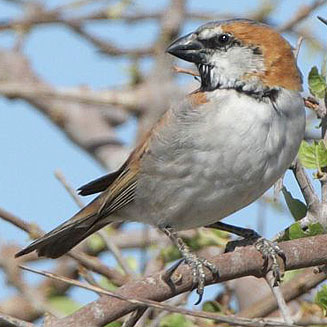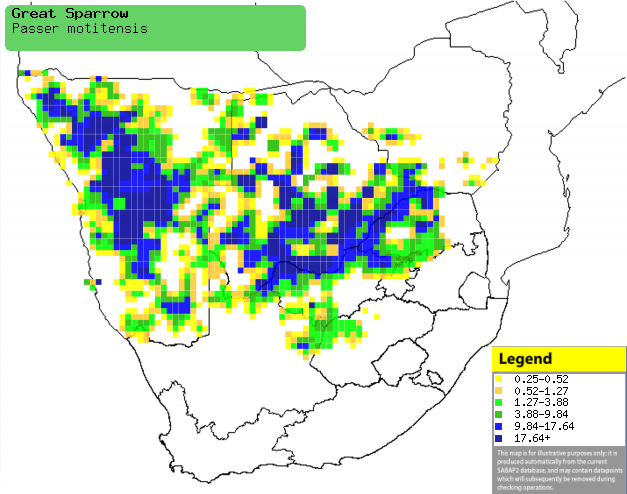|
Passer motitensis (Great sparrow)
Grootmossie [Afrikaans]; Enzunge (applied to some of the
bishops, widows and sparrows) [Kwangali]; Lemphorokgohlo la Kapa [North Sotho];
Tswere (generic term for sparrows, petronias and canaries [Tswana]; Roestmus
[Dutch]; Grand moineau [French]; Rotbrauner Sperling, Rostsperling,
Riesensperling [German]; Pardal-grande [Portuguese]
Life > Eukaryotes > Opisthokonta > Metazoa (animals) > Bilateria > Deuterostomia > Chordata > Craniata > Vertebrata (vertebrates) > Gnathostomata (jawed vertebrates) > Teleostomi (teleost fish) > Osteichthyes (bony fish) > Class: Sarcopterygii (lobe-finned fish) > Stegocephalia (terrestrial vertebrates) > Tetrapoda (four-legged vertebrates) > Reptiliomorpha > Amniota > Reptilia (reptiles) > Romeriida > Diapsida > Archosauromorpha > Archosauria > Dinosauria (dinosaurs) > Saurischia > Theropoda (bipedal predatory dinosaurs) > Coelurosauria > Maniraptora > Aves (birds) > Order: Passeriformes > Family: Passeridae
 |
|
|
Great sparrow male, Etosha National Park, Namibia. [photo
Trevor Hardaker ©] |
|
Distribution and habitat
Near-endemic to southern Africa, occurring from
south-western Angola through to Namibia, Botswana, southern Zimbabwe and
northern South Africa. It generally prefers arid and semi-arid savanna woodland
and shrubland, especially with Acacia trees, but it also occupies fallow
grazing land with scattered bushes.
|
 |
|
Distribution of Great sparrow in southern Africa,
based on statistical smoothing of the records from first SA Bird Atlas
Project (©
Animal Demography unit, University of
Cape Town; smoothing by Birgit Erni and Francesca Little). Colours range
from dark blue (most common) through to yellow (least common).
See here for the latest distribution
from the SABAP2. |
Brood parasites
It has been recorded as host of the
Diderick
cuckoo.
Food
It mainly eats seeds and insects, foraging both on the
ground and in tree foliage.
Breeding
- The nest is built by both sexes, consisting of an untidy, thick-walled
hollow ball with a side entrance, made of grass and asparagus leaves and
lined with feathers and fine grass. It is typically placed in a thorn tree
or bush, sometimes fairly exposed and easy to spot.
- Egg-laying season is from September-April.
- It lays 2-4 eggs, which are incubated by both sexes for about 12-14
days.
- The chicks are fed by both parents on a diet of insects, leaving the
nest after about 15-18 days.
Threats
Not threatened, although the clearing of large trees has
caused its range to contract.
References
-
Hockey PAR, Dean WRJ and Ryan PG 2005. Roberts
- Birds of southern Africa, VIIth ed. The Trustees of the John Voelcker
Bird Book Fund, Cape Town.
|
